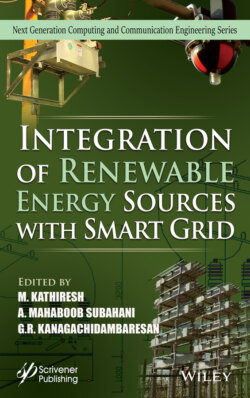Читать книгу Integration of Renewable Energy Sources with Smart Grid - Группа авторов - Страница 16
1.1.2 Wind Energy
ОглавлениеIn the current scenario, the wind energy system is one of the fastest-growing renewable energy. Wind turbine capacity has increased over time. In 1985, typical turbines had a rated capacity of 0.05 megawatts (MW) and a rotor diameter of 15 meters. Today’s new wind power projects have turbine capacities of about 2-MW onshore and 3- to 5-MW offshore. Commercially available wind turbines have reached 10-MW capacity, with rotor diameters of up to 164 meters. The average capacity of wind turbines increased from 1.6 MW in 2009 to 2 MW in 2014 [7].
Wind energy conversion system (WECS) comprises of a wind turbine, gearbox, generator, converter, and transformers as shown in Figure 1.7. The wind energy or the kinetic energy is converted to mechanical energy using a wind turbine. The mechanical energy input is given to the generator and converted into electrical energy. Permanent magnet synchronous generator, Squirrel cage induction generator or doubly fed induction generator can be used in the WECS. The AC output from the generator is converted to a required form using power electronic converter. It is then connected to grid through to a step-up transformer.
Figure 1.7 Wind energy conversion system (WECS).
The wind energy is captured by the rotor blades and transferred to rotor hub. The rotating shaft provides mechanical energy input to the generator, which is further converted into electricity. The gear box helps in increasing the rotational speed of the shaft for the generator. The power extracted by the rotor blades may be expressed as follows:
where α is perturbation factor, ρ is density of the air, A is swept area of the blades, and uo is speed of the upstream wind.
The wind turbines are largely classified into Horizontal Axis Wind Turbines (HAWT) and Vertical Axis Wind Turbines (VAWT). As the name implies, the HAWT has their blades rotating on an axis parallel to the ground. If the blades are placed in such a way that their rotational axis is perpendicular to the ground, it is called as VAWT. The HAWT can capable of producing more electricity as compared to VAWT. It is because the HAWT has more swept area than VAWT. Hence, the HAWT is generally preferred for commercial WECS. However, VAWT is used for small power applications.
